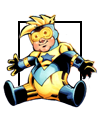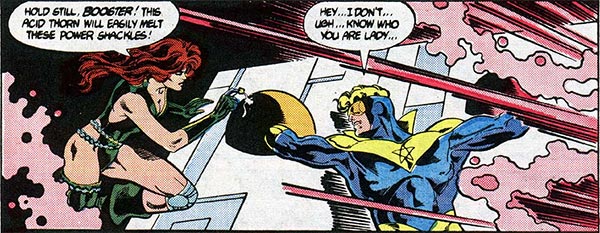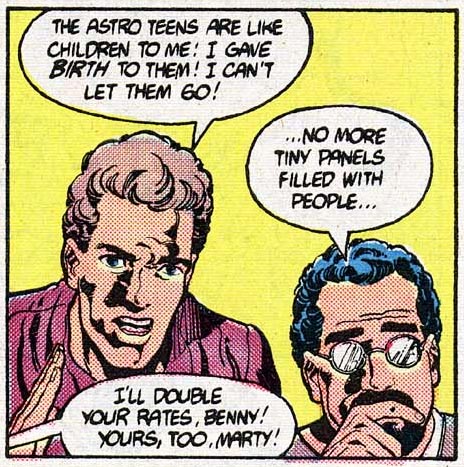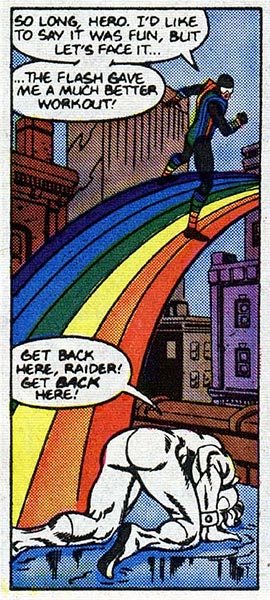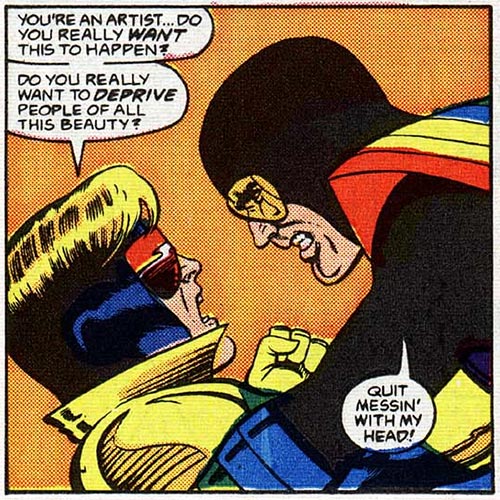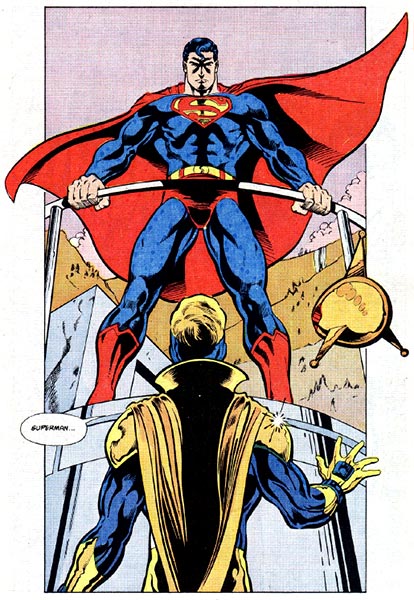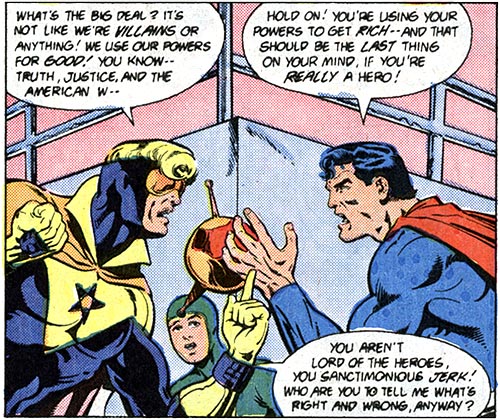
Showing posts 6 - 10 of 22 matching: true story
Friday, October 23, 2015
30 Years of Superhero Team-Ups
It's a time-honored tradition: To get some respect, the new kid on the block has to prove his chops to an established hero. The two DC characters to debut in their own title in the decade before Booster Gold, Black Lightning and Firestorm, had their first DCU team-up with Superman. Booster Gold would encounter Superman, too. But Superman wasn't Booster's first team-up. That honor went to Thorn.
You remember Thorn, right? Whenever Rose Forrest fell asleep, her alternate personality came alive and fought crime. (The first rule of Rose and Thorn is don't talk about Rose and Thorn.)
Thorn specifically focused her wrath on the 100, a criminal organization responsible for her father's death. Moderately successful, she eventually teamed up with (who else?) Superman before fading into the background of DC's shared universe.
So why did every other DC character get a career booster from Superman, but Booster Gold had to settle for Thorn? I asked Dan Jurgens that question.
First of all, I found her to be an amazingly interesting character.
Plus, since [Rose and Thorn] hadn't appeared in such a long time, it was fairly easy to adjust the character a bit. Tweak the costume, etc. Tailor it to Booster a bit more, that kind of thing.
I also asked Jurgens why he didn't include a cameo for the 100's other major nemesis, Black Lightning.
We actually talked about it a bit but realized that we had Thorn already and were going to have Superman showing up quite soon, with the [Legion of Super-Heroes] soon after. We didn't want it to become a full time guest star series.
And there you have it.

Thanks to Dan Jurgens for answering "just one more follow-up question" over and over again.
Comments (0) | Add a Comment | Tags: 100 black lightning dan jurgens origins rose and thorn true story
Friday, October 9, 2015
30 Years of Funny Pages
On the very first panel of the very first page of the very first Booster Gold comic, readers were introduced to Blaze Comics. "BC" would go on to produce the Booster Gold comic within the DC Universe, making Booster Gold a comic book character who appeared as a comic book character in a comic book.
Before Booster Gold, the most famous story to include a comic-within-a-comic must "Flash of Two Worlds" (The Flash #123, 1961). That story introduced the multiverse to readers of DC Comics when Barry Allen of Earth-1 read comics about the adventures of his predecessor Jay Garrick of Earth-2.
Because Booster Gold debuted after the multiverse-killing Crisis on Infinite Earths, his comic-within-a-comic must be about his own adventures. If you think about it, this sets up a meta-textural Droste effect, an infinite recursion of Booster Gold comic books including Booster Gold comic books.
(Could Grant Morrison have been inspired by this concept? His Animal Man stories in which superhero Buddy Baker learned he was a comic character wouldn't be published until several years later.)
What was Dan Jurgens thinking by starting his new comic with the story of the creation of a comic? Was Jurgens revealing the true, behind-the-scenes story of the creation of Booster Gold volume 1? To find out, I asked him.
I took that approach because I thought it was something readers might genuinely enjoy. There was something fun about the idea of a comic within a comic.
In retrospect, I kind of wish I had taken a couple of issues to actually build up to it.
Jurgens must have done something right. Blaze Comics has gone on to appear in both video games and movies in the years since its debut.
I also asked Jurgens whether Blaze editor Skip Andrews or artists Benny and Marty were intended to be representative of any particular real-world people. Benny and Marty evoke referenes to Marv Wolfman and George Pérez, creators of the bestselling Teen Titans comics. Did Wolfman and Pérez ever return the favor and put Jurgens in one of their comics?
I wouldn't go that far with Benny and Marty, though there may be a hint of truth to it. In a way, they were based more on the idea of team books and their creative teams of that era.
Skip Andrews was more of an amalgam, based on several editors I knew at the time.
As for any Dan Jurgens doppelgänger, that's a story still waiting to be told!
I'm sure I'm not the only one who looks forward to reading that story.

Thanks to Dan Jurgens for putting pencil to paper and giving us such great comics.
Comments (0) | Add a Comment | Tags: benny blaze comics dan jurgens flash marty origins skip andrews true story
Friday, September 25, 2015
30 Years of Drawing the Line
As anyone who saw Kevin Smith's Chasing Amy knows, a comic book inker is really just a tracer. But if you look at Showcase Presents Booster Gold, you can see how different "tracers" can influence the final product.
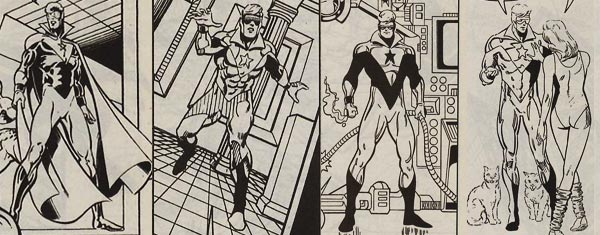
Booster Gold inked by Mike DeCarlo, Arne Starr, Ty Templeton, Robert Campanella
In addition to creating Booster Gold, Dan Jurgens drew every issue of Booster Gold volume 1. But he worked with many different inkers. Mike DeCarlo inked the book for the first year with several others, including Ty Templeton, finishing the run. This resulted in a variety of different looks for the character.
I wondered how much credit these inkers deserve for honing the visual identity of the character, so I put the question to Jurgens himself.
Booster's overall appearance, starting with the design of his costume, his general look, body language, expressiveness, etc.-- all those thing go into creating a definitive look. Far more so than the particulars of inking. For me, once I had the design I wanted, I think 90% of it was locked in.
Not to take anything away from Mike, who did a fine job, but I was doing fairly detailed pencils. Ty brought a sense of smoothness to the overall look of the book while Mike really gave the metallic portions of the uniform the look it needed. I really think that, like many things in life, each of the guys brought something good and different to the series.
Again-- that isn't to take anything away from anyone who worked on the book-- just a way of saying that far more goes into it than a simple question of who inked which issues.
It takes a village to raise a child, especially a troublesome child like Booster Gold.

Thanks to Dan Jurgens for providing so many nice images for others to trace, and thinks to Mike DeCarlo, Ty Templeton, and others to for turning Jurgens' images into our favorite comics.
Comments (0) | Add a Comment | Tags: artists dan jurgens inkers mike decarlo origins true story ty templeton
Friday, September 4, 2015
30 Years of Full Color Action
As I said two weeks ago, the first volume of Booster Gold was in many ways a re-investigation of the heroic ideal of the DC Universe. But Dan Jurgens didn't draw the line at exploring what made a hero. He also took a hard look at what made a villain.
Jurgens tended to humanize Booster's villains, giving them reasonable backstories that were filled with the same short of hardships that Booster Gold was struggling to overcome. Sometimes that resulted in characters like Broderick or Dirk Davis, but it didn't always work. No matter how much you pathos you give to a color-blind man who dresses like a prism, he's still going to look like a clown.
Of course I asked Jurgens what his motive was for bringing the Rainbow Raider, one of the least successful of Flash's foes, to Metropolis. Why choose him, a villain with a lackluster Silver Age-style gimmick, to feature in a two-part story against a modern anti-hero like Booster Gold?
I though it'd be fun to play off the color angle. Plus, I liked the visual of him riding his rainbow.
Not my best day.
So not everything can be Shakespeare. It's important to remember that sometimes a funny-book is just a funny book.

Despite that Rainbow Raider story, we still thank you, Mr. Jurgens.
(Reminder: no post on Monday because of the Labor Day holiday. Blogging is hard work!)
Comments (2) | Add a Comment | Tags: dan jurgens origins rainbow raider true story
Friday, August 21, 2015
30 Years of Tugging on Superman's Cape
One hero stands above all others as the metric by which heroism should be judged. Obviously I'm talking about...
No matter what generation you're from, Superman is the paragon of all that is altruistic and moral in the DC Universe. He was raised with a strong code of ethics and strives to use his tremendous power to make the world a better place. He never cheats, yet he always wins. It takes a Man of Steel to live up to his ideals.
It's only natural that a more flawed, human hero, Booster Gold, looks worse standing in Superman's shadow. Booster is jealous of Superman's power and fame, but he also resents the fact that he can't meet the standard that Superman's sets. Comparisons between the two heroes provide a lot of drama throughout Booster Gold Volume 1.
The late 1980s were largely defined by the deconstruction of super-hero mythos. (Alan Moore's Swamp Thing and Grant Morrison's Animal Man were contemporaries of the original Booster Gold.) In hindsight, it's natural to ask whether Dan Jurgens was, like his fellow writers at DC Comics, intentionally using anti-hero Booster Gold to tear down what made Superman tick in order to investigate what it meant to be a super man in the DC Universe?
I was aware of it but I don't think I would, at that time, have phrased it that way.
I simply wanted to do something different. Superman was the pinnacle-- the absolute king of heroes. Booster could never aspire to that so he had to take a very different approach. He never wanted to be iconic-- at least not in the way Superman was. He wanted notoriety, but knew he could never have that level of unquestioning trust from the public that Superman enjoyed.
In general, I think handled Superman fairly well. I did, however, write him a little more staid so Booster's differences would stand out.
When Jurgens would get his chance to write for the Man of Tomorrow, he turned in some of the best Superman stories of all time. So I think we can forgive him if his early Superman appearances seem a little stiff.

Thanks to Dan Jurgens for, well, everything.
Comments (0) | Add a Comment | Tags: dan jurgens origins superman true story
SITE SEARCH
SPOILER WARNING: The content at Boosterrific.com may contain story spoilers for DC Comics publications.
Booster Gold, Skeets, and all related titles, characters, images, slogans, logos are trademark ™ and copyright © DC Comics unless otherwise noted and are used without expressed permission. This site is a reference to published information and is intended as a tribute to the artists and storytellers employed by DC Comics, both past and present. (We love you, DC.) Contents of this page and all text herein not reserved as intellectual property of DC Comics is copyright © 2007-2024 BOOSTERRIFIC.com. This page, analysis, commentary, and accompanying statistical data is designed for the private use of individuals and may not be duplicated or reproduced for profit without consent.
